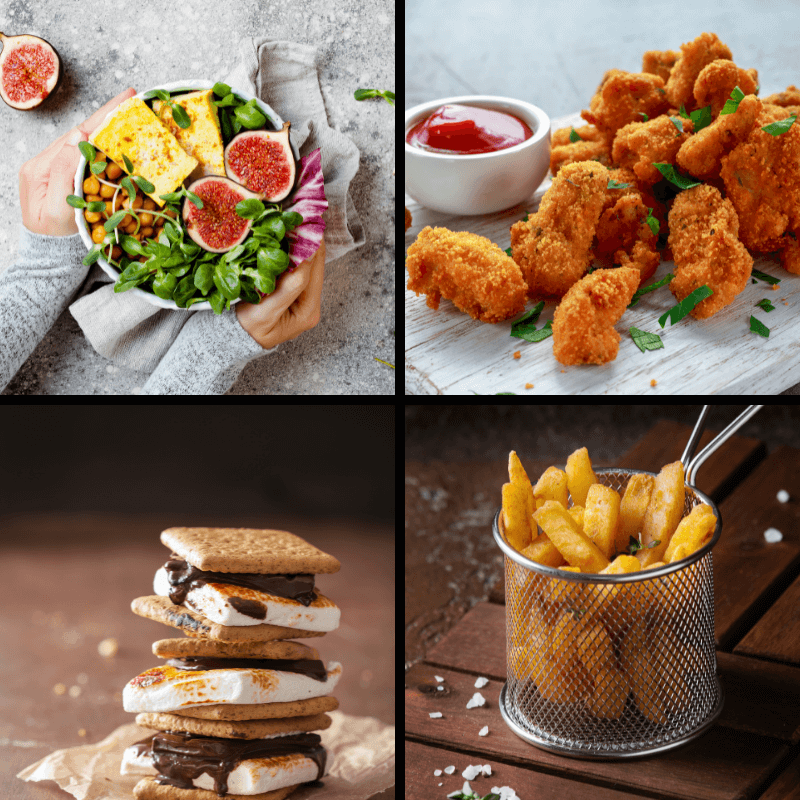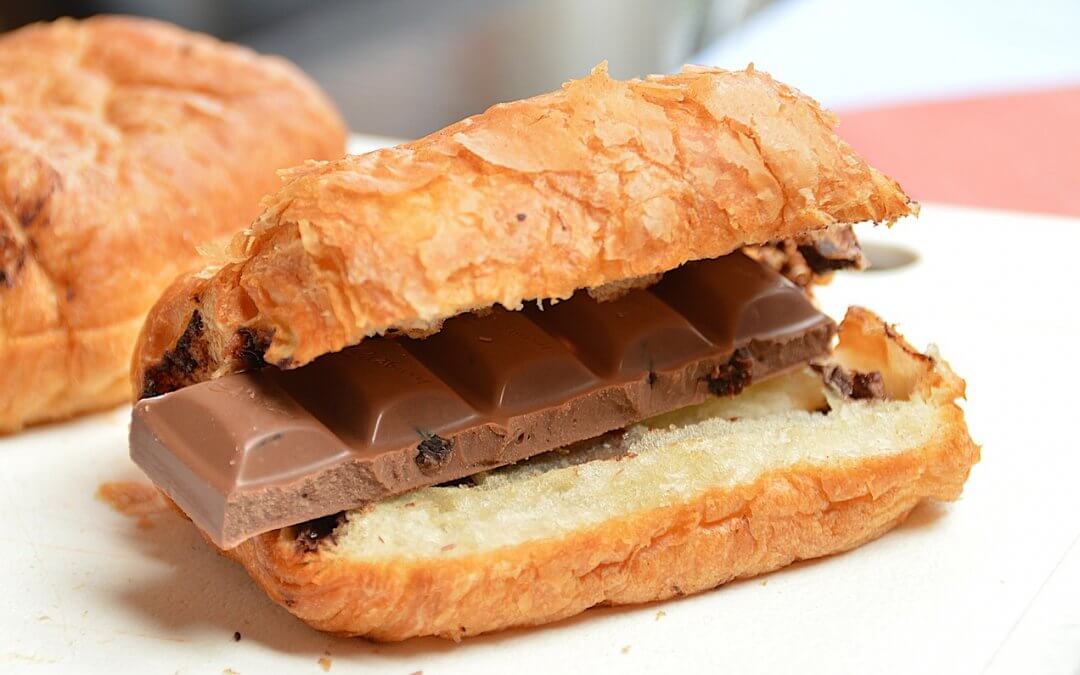Maybe your breast cancer IS your fault.
You drank the booze and ate all the fatty, sugary, floury, fried, processed, battered, crunchy, salty foods you love.
Because everyone knows saying “no” to food you love is torture, and who willingly submits herself to torture?
You, maybe.
To lose weight. Eat healthier. Feel virtuous.
Those may have been your reasons BEFORE CANCER, but now that you’re in post-treatment survivorship, avoiding foods you love has taken on a new urgency.
You’re convinced foods you love will make your cancer come back, or if you’re living with metastatic breast cancer, grow.
And it will be your fault. 
So you decide to cut ALL the “questionable” foods you LOVE from your diet.
Oh my friend, if it were only that straightforward.
THE WAY FOOD WORKS ON BREAST CANCER
The good news is, the foods we choose can have a positive impact on recurrence risk, which is why I encourage everyone to uplevel their diet from day one of their diagnosis.
But please know this.
No SINGLE food improves your breast cancer survival rate or reduces recurrence risk.
It’s your overall pattern of eating that has the most impact.
MEAL PATTERN EXPLAINED
As with other professions, dietitians have our own industry lingo.
Dietary pattern, meal pattern or eating pattern all mean the same.
“Formal” Nutrition Science Definition:
The term ‘meal patterns’ is an overarching construct that’s often used to describe individuals’ eating patterns at the level of a ‘meal’, such as a main meal (for example, breakfast, lunch or dinner) or a smaller-sized meal (for example, supper or snack). (1)
“Informal” Cathy’s Definition:
A meal pattern is a unique-to-you road map showing the variety, balance, quality and nutrients in your “usual” diet. It’s a FOOD COLLAGE of how you typically eat, rather than a SINGLE-FOOD SNAPSHOT of how you occasionally eat.
For example, if you eat home-cooked meals most often, 7-9 servings of fruit and vegetables daily, and avoid alcohol except on rare occasions, your FOOD COLLAGE closely resembles the recommendations for a diet that MAY reduce risk of recurrence. (2)
On the other hand, if you eat out regularly (take-out, drive-through, curbside pick-up, delivery), avoid fruits and veggies, and boast a well-stocked (and sampled) wine selection, your FOOD COLLAGE differs dramatically from cancer-protective recommendations.
But listen!
Even if you eat and avoid everything you “should”, you can still have a recurrence. Your cancer can still spread.
There’s no guarantee.
Lack of guarantees aside, I’m a staunch advocate for a cancer-protective dietary pattern. Research continues to grow in support of its benefit, and current data we DO have is encouraging. (3)
Beyond that, eating better helps decrease your risk for diabetes, heart disease and other medical conditions. When you eat for BREAST HEALTH, you support your overall BEST health.
Since I’ve now convinced you that your PATTERN of eating is most important, you may be wondering which foods to eliminate from that pattern in order to improve your odds.
IT’S OKAY TO BE FLEXIBLE WITH FOOD
Any food, regardless of what it is, will give you some combination of calories, fat, protein, carbohydrates, vitamins and minerals.
Take hard candy for example.
- Is it a food? Yes. (4)
- Does it have vitamins and minerals? No.
- Does it have fat and protein? No.
- Is it quality nutrition? Hell no.
But it does have calories and carbohydrates. If you were stranded somewhere with nothing to eat but an endless supply of hard candy. . .you’d survive.
The calories and carbs would fuel your brain and body to keep you alive!
In this specific example, is hard candy quality fuel? Absolutely. 
But in your not-stranded, day-to-day life, you may take a hard line on hard candy, and decide it’s not a food that fits your breast cancer diet.
Or is it?
THE DANGER OF CREATING FOOD SCARCITY
Everyone knows hard candy isn’t health food, but for those who love it, it offers other benefits.
Like the pure joy of eating it.
If you adore hard candy, banishing it from your diet is that torture I spoke of earlier.
It drives feelings of deprivation, guilt and shame. You likely consider yourself bad when you “allow yourself” to eat it.
Lying, cheating, and stealing make you bad. Eating hard candy does not.
GIVING YOURSELF GRACE
Creating strict food rules and a rigid food world to control your risk of recurrence or metastasis may sound like a helpful approach. In truth, it’s a path to an unhealthy relationship with food.

Food is meant to nourish us in many ways. Allowing yourself to ENJOY rather than FEAR food encourages the joy of eating.
Almost all of my clients tell me their fear and anxiety around food has STOLEN THEIR JOY OF EATING.
Let’s work to bring the joy back, shall we? Here are a few tips to get you started:
- Choose high quality foods because eating better makes you feel better, not because you’re following draconian rules.
- Be mindful of breast cancer nutrition recommendations, but include ALL the foods you love in your eating pattern.
- Enjoy less healthy foods on occasion, minus the side dish of guilt, shame and dread.
FOODS TO AVOID
Listen, before you dive into this list, please know this.
I would make these recommendations even to women who haven’t gone through breast cancer. Eating better makes you feel better AND supports overall good health!
These are foods/beverages you may choose to limit and/or avoid. . .or not. It’s up to you to take the information and use it in a way that fits your needs.
Breast cancer nutrition research suggests these are foods to consume occasionally, but as I said, anyone looking to improve their diet would benefit from reducing these foods. (6)
- Added sugar
- Animal fats
- Hydrogenated oils
- Alcohol
- Refined grains
- Fried foods
In summary, keep the following in mind:
- Foods high in sugar, unhealthy fats and artificial ingredients aren’t the best choices, but they didn’t cause your breast cancer, nor can they be directly responsible for recurrence.
- Food patterns vs individual foods determine how healthy your diet is.
- Denying yourself foods you love triggers deprivation and reeks of diet culture; the opposite of EATING WITH JOY!
- Eating healthy is never a bad idea, yet sometimes you choose to eat simply for pure enjoyment vs optimal nutrition. And that’s okay.
- Be deliberate and intentional in nourishing your body, yet stay flexible in your choices.

If you found this post helpful, do you know someone in the breast cancer community who would also benefit from reading it? Please SHARE!
_____________________________________________________________________________
Thanks for reading my blog post!
Most survivors of hormone-positive breast cancer get anxious when they think about what to eat after finishing treatment, so I’ve created the Peaceful Plate program to help survivors eat with peace, not panic.
When you eat with peace, you feel free to enjoy your food again.
Ready to eat with peace?
CLICK HERE and grab your FREE copy of The Five Foods Survivors Should Eat
CLICK THIS LINK and watch my 2-minute Peaceful Plate program video!
Follow me on Instagram @hormone.breastcancer.dietitian
This information is for educational purposes only, and is not intended as medical advice. Please consult your doctor or dietitian for nutritional guidance specific to your needs.
SOURCES
- Understanding meal patterns: definitions, methodology and impact on nutrient intake and diet quality
- Cancer Prevention – American Institute for Cancer Research
- Reducing the Risk of Breast Cancer Recurrence: an Evaluation of the Effects and Mechanisms of Diet and Exercise
- Definition of FOOD
- Breast Cancer. How diet, nutrition and physical activity affect breast cancer risk.

